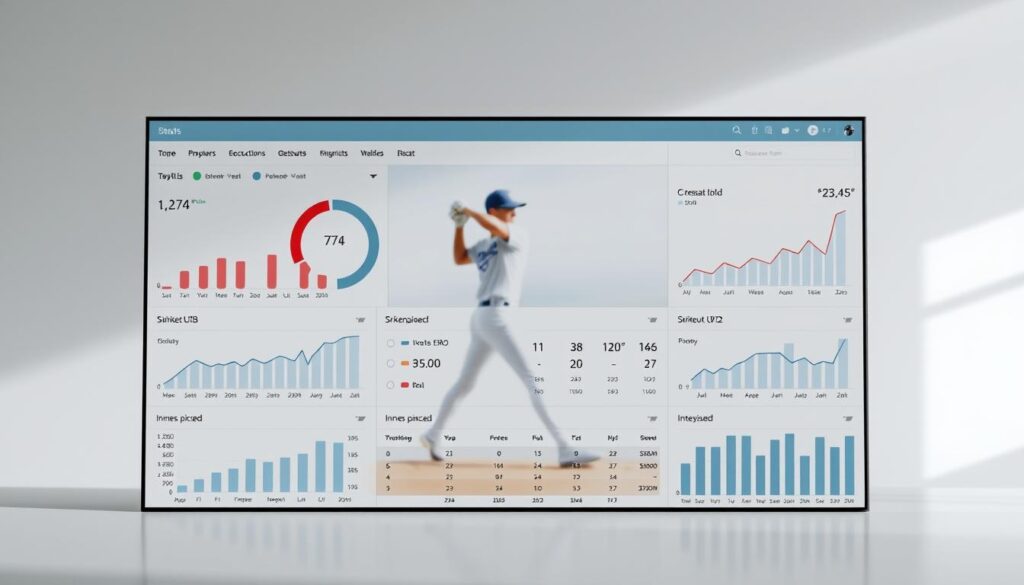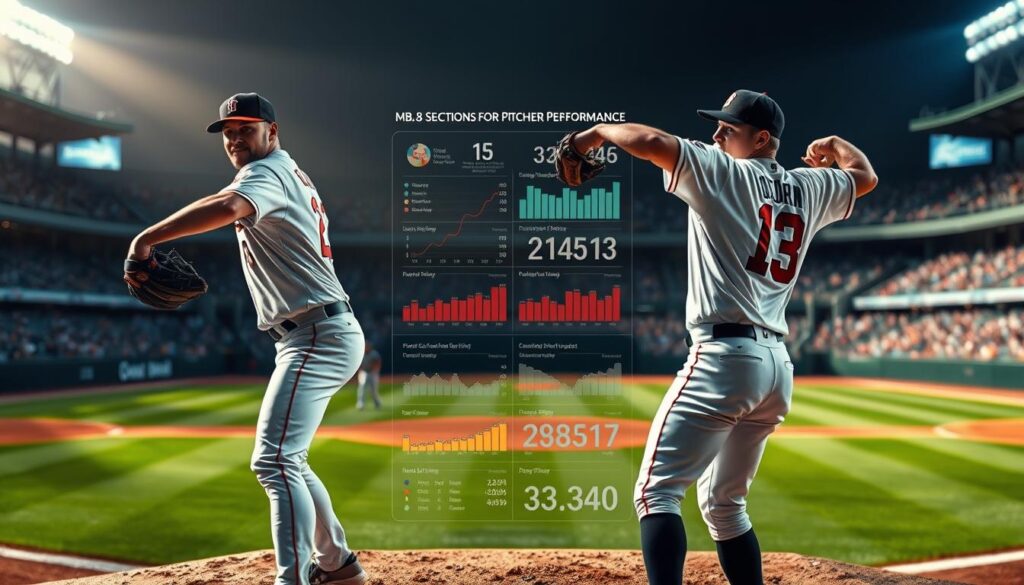Did you know that Paul Skenes boasts the fastest fastball velocity in the league at 98.8 mph? This is just one of the many standout stats that make him a player to watch. As we look ahead, analyzing last year’s performance and strikeout rate becomes crucial in predicting future success1.
Our rankings are built on expert insights and updated injury reports, ensuring accuracy and relevance. Whether you’re a fan or a fantasy manager, this guide will help you stay ahead of the game2.
Key Takeaways
- Analyzing last season’s data is key to predicting future performance.
- Strikeout rate remains a critical metric for evaluating talent.
- Expert insights and injury updates shape our rankings.
- This guide is designed for both fans and fantasy managers.
- Stay informed with the latest stats and trends.
Introduction to the 2025 MLB Pitchers Landscape
The 2025 baseball landscape is shaped by last year’s standout performances and evolving trends. As we look ahead, understanding the key factors that define this era of pitching is essential. Consistency, mechanics, and era improvements are at the forefront of what makes a pitcher successful3.
Last year’s statistics provide a solid foundation for predicting future success. For instance, Paul Skenes averaged 98.8 mph on his fastball, the highest among starters, while Tarik Skubal showcased a 30.3% strikeout rate4. These numbers highlight the importance of analyzing performance trends.
Overview of the Season’s Key Factors
Performance consistency remains a critical metric. Pitchers like Chris Sale and Logan Gilbert demonstrated how a strong era and WHIP can set them apart4. Additionally, understanding pitching mechanics from the past year helps identify areas for improvement.
Teams are also focusing on roster flexibility. Strategies like drafting four reliable starters and targeting high-upside players are becoming more common3. This approach ensures stability while allowing for early adjustments.
What Made 2024 Stand Out
The 2024 season was marked by significant achievements. Blake Snell led the majors with 103 strikeouts in the second half, while Garrett Crochet recorded a 35.1% strikeout rate4. These performances set new benchmarks for the upcoming year.
Analyzing era numbers and season-long trends is crucial. For example, the Marlins’ early schedule included favorable matchups against PIT, NYM, and WSN, which benefited their pitchers3. Such insights help teams plan strategically.
For a deeper dive into the financial dynamics influencing this landscape, explore the rising salaries of top players. This analysis highlights how performance and market trends shape player contracts.
Key Metrics to Evaluate Pitcher Performance
Evaluating a pitcher’s effectiveness requires a deep dive into advanced metrics. While traditional stats like ERA provide a snapshot, strikeout rate, walk ratio, and WHIP offer a more comprehensive view. These metrics help us understand consistency, durability, and overall performance over time.

Strikeout rate, for instance, measures how often a pitcher retires batters via strikeouts. A higher rate often indicates dominance on the mound. For example, Ryan’s 2024 season saw a 27.3% strikeout rate, showcasing his ability to overpower hitters5.
Walk ratio, on the other hand, highlights control. A lower ratio means fewer free passes, which is crucial for maintaining pressure on opposing teams. WHIP (Walks plus Hits per Inning Pitched) combines these elements, offering insights into a pitcher’s ability to limit base runners. Ryan’s 0.99 WHIP in 2024 is a testament to his efficiency5.
Analyzing Consistency and Durability
Metrics like WHIP and innings pitched reveal a pitcher’s durability. Houck’s 178.2 innings in 2024 demonstrate his ability to handle a heavy workload while maintaining a 3.12 ERA5. This consistency is vital for teams relying on their starters to anchor the rotation.
Advanced metrics also help identify emerging talents. Jax’s 2.03 ERA and 34.4% strikeout rate in 2024 highlight his potential as a dominant force5. By comparing these stats, we can pinpoint pitchers with high efficiency and low error rates.
Our analysis includes elite performers and rising stars, ensuring a balanced evaluation. These metrics not only quantify performance but also help predict future success. By focusing on strikeout rate, walk ratio, and WHIP, we gain a clearer picture of what makes a pitcher truly effective.
Top MLB pitchers 2025 season: Expert Rankings
Expert rankings provide a clear snapshot of the most dominant arms in the game. Our analysis is based on comprehensive data from last season, focusing on key metrics like WHIP, arm strength, and the quality of starting assignments. These factors are critical in evaluating a player’s overall effectiveness6.
For instance, Tarik Skubal’s team went 21-10 in games he started, showcasing his impact on the mound6. Similarly, Paul Skenes recorded a 5.9 WAR in his rookie season, highlighting his potential as a future star6. These performances underline the importance of analyzing WHIP and other advanced metrics.
Here’s what sets our rankings apart:
- We focus on WHIP numbers to measure a pitcher’s ability to limit base runners.
- We evaluate the quality of starting assignments, ensuring a balanced assessment of performance.
- We consider arm strength and durability, key factors in long-term success.
- We integrate injury updates and trade rumors to provide a comprehensive view.
For example, Logan Gilbert led the league in WHIP last season, with a 2.49 ERA at home7. His consistency makes him a standout in our rankings. Meanwhile, Jacob deGrom’s 1.69 ERA in his late-season return demonstrates his elite arm strength and control6.
These insights set the stage for a deeper dive into individual profiles in subsequent sections. Stay tuned for more detailed analysis and updates.
Evaluating Last Season’s Stats and Trends
Understanding the numbers behind last year’s performances is crucial for predicting future success. We dive into key metrics like inning totals, ERA consistency, and pitch velocity to uncover what drove performance in 2024. These stats not only highlight individual achievements but also reveal broader trends shaping the game.

Inning Totals and ERA Explored
In 2024, starting pitchers averaged 5.22 innings per start, a slight increase from the previous year8. This trend reflects a focus on durability and efficiency. For example, pitchers like Jacob deGrom maintained a 1.69 ERA in late-season starts, showcasing elite control and stamina9.
ERA remains a critical metric for evaluating performance. Teams with lower ERAs often benefit from strong defensive support and strategic pitching rotations. Analyzing these numbers helps identify pitchers who consistently deliver under pressure.
Velocity and Pitching Mechanics
Pitch velocity is another key factor in performance. In 2024, the average exit velocity dropped to 93.1 mph, indicating improved pitching mechanics8. Pitchers like Yoshinobu Yamamoto recorded a 28.1% strikeout rate, highlighting the importance of speed and precision9.
Mechanics also play a role in reducing walks and increasing strikeouts. For instance, George Kirby achieved a sub-3% walk rate in both 2023 and 2024, demonstrating exceptional control9. These improvements are critical for maintaining dominance on the mound.
By analyzing these trends, we gain valuable insights into what drives success. Whether it’s strikeout totals or team dynamics, these stats shape our projections for the future. Stay tuned as we explore how these factors influence upcoming performances.
Impact of Injuries on Pitcher Projections
Injuries play a pivotal role in shaping the future of players and their performance. A single setback can alter a player’s trajectory, especially when it affects key metrics like velocity and overall durability. For instance, a reduction in mph on a fastball can significantly diminish a pitcher’s effectiveness on the mound10.
League-wide injury trends are also crucial to consider. Teams and fantasy managers must stay updated on recovery timelines and overall health. Recent updates, such as Luis Gil’s injury timeline, highlight the importance of monitoring these factors11.
Recovery time is another critical element. Players returning from injuries often face challenges in regaining their peak form. For example, Jacob deGrom’s limited innings in the previous season demonstrate how injuries can disrupt even the most elite performers11.
Understanding these dynamics helps us project future performance more accurately. By factoring in velocity changes, recovery timelines, and league trends, we can better assess a player’s potential and make informed decisions.
Historical Comparisons: Last Year’s Performance
Looking back at the 2024 season, several standout performances reshaped the pitching landscape. By comparing historical data with recent trends, we gain valuable insights into what drives success. This analysis helps us understand how players have evolved and what to expect in the future.

Key Moments and Statistical Breakthroughs
The 2024 season was marked by breakthrough performances that redefined player tiers. For example, Tarik Skubal led all majors in strikeouts, capturing the AL pitching Triple Crown with 211 innings pitched12. Similarly, Paul Skenes led in both ERA and xERA in his first professional season, showcasing his potential12.
Specific games also played a pivotal role in shaping narratives. Garrett Crochet’s 12.9 K/9 rate highlighted his dominance, while Framber Valdez’s 1.91 ERA over his final 13 starts solidified his elite status12. These moments not only defined the season but also set new benchmarks for future success.
Injuries and recoveries further influenced player tiers. Gerrit Cole returned from injury but struggled with his slider, while Reynaldo López missed time in the second half due to health issues12. Understanding these dynamics helps us project how players will perform moving forward.
Historical markers like these are crucial for predicting future trends. For instance, Logan Gilbert’s 220 strikeouts and league-leading WHIP demonstrate the importance of consistency12. By analyzing these stats, we can identify players poised for long-term success.
For more insights into how emerging talent is shaping the game, explore the preseason Top 25 Rankings. This resource highlights the programs and players to watch as the season unfolds.
Advanced Analytics: FIP, xFIP, and SIERA
Advanced metrics like FIP, xFIP, and SIERA are reshaping how we evaluate pitching talent. These tools provide a deeper understanding of what drives success on the mound, offering insights beyond traditional stats like ERA. For fantasy managers and scouts, mastering these metrics is key to making informed decisions.
Decoding Advanced Pitching Metrics
FIP (Fielding Independent Pitching) focuses on outcomes a pitcher can control: strikeouts, walks, and home runs. It removes the influence of defense, providing a clearer picture of individual performance. For example, Hunter Greene’s 2024 FIP was 3.47, indicating solid control despite his ERA of 4.8213.
xFIP (Expected Fielding Independent Pitching) adjusts FIP by normalizing home run rates. This metric is particularly useful for evaluating pitchers in hitter-friendly ballparks. Greene’s xFIP of 4.30 suggests potential improvement if his HR/FB% stabilizes13.
SIERA (Skill-Interactive ERA) goes further, incorporating factors like groundball rates and strikeout-to-walk ratios. It’s park-adjusted and updated for the modern low-scoring environment, making it a reliable predictor of future performance. SIERA is more predictive than FIP and xFIP, but only slightly14.
Here’s how SIERA ratings break down:
| Rating | SIERA Value |
|---|---|
| Excellent | 2.90 |
| Great | 3.25 |
| Above Average | 3.75 |
| Average | 3.90 |
| Below Average | 4.20 |
| Poor | 4.50 |
| Awful | 5.00 |
These metrics are invaluable for evaluating starting pitcher performance and making strategic decisions in baseball drafts. For instance, Reynaldo López’s 2024 SIERA of 3.8, combined with his unexpected ERA under 2.00, highlights his potential for regression13.
By integrating advanced analytics into your strategy, you can identify undervalued players and avoid overpaying for unsustainable performances. Whether you’re scouting for a team or preparing for a fantasy draft, these tools are essential for staying ahead in the game.
Spotlight on Rookie Phenoms and Breakout Stars
The future of baseball shines bright with a new wave of talent making their mark. This season, rookie phenoms and breakout stars are capturing attention with their exceptional skills and potential. From draft day expectations to early-season performances, these players are redefining the game.
One standout is Roki Sasaki, ranked as the top prospect with a Future Value (FV) grade of 6515. His ability to dominate on the mound has already set him apart. Similarly, Jasson Dominguez, the Yankees’ No. 1 prospect, is a legitimate 20/20 candidate for the upcoming season, showcasing his power and speed16.

Breakout stars like Roman Anthony and Kristian Campbell are also making waves. Anthony follows Dominguez in Rookie of the Year odds at +550, while Campbell is tied at +80016. Their performances highlight the depth of emerging talent in the league.
Advanced metrics further emphasize their potential. For instance, Dominguez’s projected 20+ home runs and 20+ stolen bases underscore his versatility16. These stats not only reflect individual achievements but also hint at their future impact on team strategies.
Here’s a closer look at what makes these players special:
| Player | Key Stat | Projected Impact |
|---|---|---|
| Roki Sasaki | FV Grade: 65 | Elite starter potential |
| Jasson Dominguez | 20/20 candidate | Dynamic offensive threat |
| Roman Anthony | ROY Odds: +550 | Consistent run producer |
| Kristian Campbell | ROY Odds: +800 | Versatile contributor |
These young talents are not just making headlines; they’re shaping the future of the game. For more insights on breakout players, explore our analysis of game-changers to watch. This resource highlights the players poised to define the narrative in the coming years.
Profiles of Top Pitcher Tiers
Pitcher tiers provide a clear framework for understanding the hierarchy of talent in the game. By categorizing players based on performance and potential, we can better evaluate their value and draft strategies. This section breaks down the top tiers, focusing on aces, elite starters, and those on the cusp of greatness.
The Aces and Elite Starters
At the top of the hierarchy are the aces, pitchers who consistently dominate and anchor their teams. Tarik Skubal, for example, held a key spot in the rotation with a 96.8 mph fastball and 211 innings pitched in 20247. His ability to deliver under pressure makes him a cornerstone for any team.
Paul Skenes, another standout, showcased his elite potential with 16 outings of 6+ innings and a 5.9 WAR in his rookie season7. These players not only excel in traditional stats but also demonstrate the upside to elevate their teams in critical moments.
One Step from Acehood
Just below the aces are pitchers with the potential to reach elite status. Logan Gilbert, for instance, led the majors in WHIP while ranking 6th in strikeouts7. His consistency over the month and ability to perform in high-pressure situations highlight his near-ace status.
Garrett Crochet also stands out with a 35.1% strikeout rate and 32 starts in 20247. These pitchers are on the brink of greatness, offering significant upside for teams willing to invest in their development.
For a deeper dive into how these tiers influence draft strategies, explore our fantasy baseball rankings. This resource provides valuable insights into building a winning rotation.
Future Trends in Pitcher Performance
The evolution of pitching mechanics and player development is reshaping the future of the game. Emerging talent and innovative training methods are driving significant improvements. We analyze how these factors, along with home park advantages and career progression, are influencing performance.

One key area of focus is the change in pitching mechanics. For example, Sean Manaea improved his ERA to 3.09 over his final 12 outings after adjusting his arm slot17. Such adjustments highlight the importance of refining techniques to achieve consistency.
Emerging Talent and Improvement Areas
Young players like Shane Baz are making strides, with 22% strikeout rates in 2024 despite a drop in SwStr rates18. These improvements are crucial for their long-term success. Similarly, Cristopher Sánchez showed potential with a 1.24 WHIP and 9.0 hits-per-nine last year18.
Home park factors also play a significant role. Nick Pivetta’s ERA splits show a clear advantage on the road, with a 3.56 ERA compared to 4.54 at home19. Understanding these dynamics helps teams optimize their rotations.
Here’s a breakdown of key trends shaping the future:
| Trend | Impact |
|---|---|
| Mechanical Adjustments | Improved ERA and consistency |
| Emerging Talent | Higher strikeout rates and WHIP improvements |
| Home Park Factors | Influence on ERA and overall performance |
| Career Progression | Long-term development and durability |
These trends are not just reshaping individual careers but also influencing team strategies. As we look ahead, the focus on innovation and adaptability will continue to drive success on the mound.
Team Strategies and Pitching Depth Analysis
Effective team strategies often hinge on how well a manager utilizes their pitching depth. The way teams handle their rotations can make or break a season. By analyzing recent trends, we can see how smart deployment of pitchers and optimized ball usage lead to success20.
One key strategy is ensuring a deep rotation. For example, Logan Gilbert pitched over 150 innings in 2023, showcasing his durability and value to his team20. This kind of consistency allows managers to rely on their starters without overworking them.
Advanced analytics play a crucial role in forming these strategies. Teams now use data to determine the best way to deploy their pitchers. For instance, Dylan Cease saw a performance boost in San Diego, thanks to a strong defense and a pitcher-friendly park20.
Here are some successful strategies from recent seasons:
- Prioritizing durability in starters to reduce bullpen strain.
- Using advanced metrics to optimize pitcher matchups.
- Focusing on ballpark factors to maximize performance.
These strategies not only improve team performance but also enhance fantasy value. For more insights on drafting strategies, explore our fantasy baseball guide.
Long-term success often depends on how well a team adapts to challenges. For example, Chris Sale’s projected 90% production of his previous year’s performance highlights the importance of managing workload20. By focusing on these factors, teams can build a sustainable advantage.
Influence of Ballpark and Market Factors on Stats
Ballpark factors and market conditions play a pivotal role in shaping player performance. From weather conditions to defensive alignments, these elements can significantly impact pitching efficiency. Understanding these external factors helps us evaluate raw statistical rankings more accurately21.

Different venues present unique challenges and opportunities. For example, left-handed batters saw a 42% increase in home runs in Cincinnati but a 23% decrease in San Francisco over the last three seasons21. These variations raise important questions about how we assess player performance.
Effect of Venue on Pitching Efficiency
Home versus road stats often reveal stark contrasts. Bobby Witt Jr. had a 202 wRC+ and a 1.117 OPS at home last season, compared to a 134 wRC+ and .844 OPS on the road21. This highlights how support systems in each park can influence outcomes.
Walk rates and other metrics are also impacted by ballpark environments. For instance, Kauffman Stadium saw a 13% decrease in strikeouts over the last three years, the highest in the league21. Such data underscores the importance of considering venue-specific factors.
Here’s a comparison of how different ballparks affect key stats:
| Ballpark | Impact |
|---|---|
| Cincinnati | 42% increase in HR for left-handed batters21 |
| San Francisco | 23% decrease in HR for left-handed batters21 |
| Kauffman Stadium | 13% decrease in strikeouts21 |
| Oracle Park | 21% decrease in HR for right-handed batters21 |
| Dodger Stadium | 26% increase in HR for right-handed batters21 |
By analyzing these trends, we can better understand how ballpark and market factors shape player performance. This knowledge is crucial for both team strategies and fantasy draft considerations.
Fantasy Draft Considerations and Market Value
Fantasy baseball drafts require a strategic approach to maximize value and secure top-tier talent. By focusing on individual stuff and overall consistency, managers can identify players who offer the best return on investment. This section outlines key considerations for building a winning roster.
One of the most critical factors is a player’s stuff, which includes pitch velocity, movement, and control. For example, Paul Skenes boasts a fastball averaging 98.8 mph, making him a standout in this category22. Similarly, Tarik Skubal’s 96.8 mph fastball and 211 innings pitched highlight his durability and dominance22.
Consistency is another essential metric. Logan Gilbert led the majors in WHIP while ranking 6th in strikeouts, showcasing his ability to perform under pressure22. These stats are invaluable for managers looking to draft reliable starters.
| Player | Key Stat | Projected Value |
|---|---|---|
| Paul Skenes | 98.8 mph fastball | $38 (Mixed 5×5)22 |
| Tarik Skubal | 96.8 mph fastball | $37 (Mixed 5×5)22 |
| Logan Gilbert | 2.49 ERA at home | $33 (Mixed 5×5)22 |
| Jacob deGrom | 97.3 mph fastball | $31 (Mixed 5×5)22 |
Injury history also plays a significant role in determining value. For instance, Jacob deGrom’s limited starts in 2024 due to injury impacted his overall ranking22. Managers must weigh the risk of drafting players with a history of injuries against their potential upside.
Balancing risk and reward is crucial. Targeting ace-level talent at a favorable price can give managers a competitive edge. For example, Blake Snell’s 1.23 ERA post-All-Star Break makes him a high-upside pick22. Similarly, Garrett Crochet’s 35.1% strikeout rate highlights his potential as a breakout star22.
For more insights on drafting strategies, explore our analysis of Tyreek Hill’s 2024 NFL season. This resource provides valuable context on how performance trends influence draft decisions.
Expert Predictions and Future Outlook
As we look ahead, expert predictions and future outlooks are shaping the narrative for the upcoming baseball season. Analysts are focusing on key factors like home run suppression, player consistency, and park factors to forecast performance. These insights help us understand how rankings might shift and what to expect in the coming months.

Changes in Rankings and Update Frequency
Rankings are dynamic, and updates are frequent as new data emerges. For example, Chris Sale’s 2.38 ERA and 32.1% strikeout rate in 2024 make him a strong candidate for top-tier status23. Similarly, Tyler Glasnow’s 3.49 ERA and 32.2% strikeout rate highlight his potential to climb the ranks23.
Factors like home run rates and player durability play a significant role in these changes. For instance, Logan Webb’s 56.8% ground-ball rate and 204.2 innings pitched demonstrate his ability to maintain consistency23. These metrics are crucial for predicting future performance.
Anticipated Trade Rumors and Injury Updates
Trade rumors and injury updates are always a hot topic. Players like Reynaldo López, with a 1.99 ERA and 27.3% strikeout rate, could be key targets for teams looking to bolster their rotations23. Meanwhile, injuries can drastically alter a player’s trajectory, as seen with Jacob deGrom’s limited starts in 202424.
Teams are also considering park factors when making trades. For example, a player moving to a pitcher-friendly park could see a significant boost in performance. These considerations are vital for both real-world teams and fantasy managers.
For more insights on how trades can impact team dynamics, explore our analysis of the 2024 NFL trade deadline rumors. This resource highlights the strategic decisions teams make to enhance their playoff prospects.
Data-Driven Insights from Recent Web Sources
Data-driven insights are transforming how we evaluate player performance and predict future success. By synthesizing key data points from multiple reputable sources, we provide a comprehensive view of the current landscape. This approach ensures our projections are grounded in robust analysis and ongoing updates25.
One critical part of our analysis is the focus on health metrics. For example, Roki Sasaki’s fastball, clocked at 102.5 mph, highlights the importance of physical conditioning in maintaining elite performance26. Similarly, injury reports and recovery timelines play a pivotal role in shaping player projections25.
Breakout performances also inform our evaluations. Players like William Contreras, who averaged 20 home runs over three seasons, demonstrate the impact of consistent improvement25. These metrics help us identify emerging talents and assess their potential for long-term success.
Here’s a breakdown of key metrics and their reliability in predicting future performance:
| Metric | Reliability |
|---|---|
| Health Metrics | High |
| Breakout Performances | Moderate to High |
| Advanced Analytics | High |
| Injury Reports | Moderate |
Recent updates and trends are critical for understanding the current landscape. For instance, the 2026 MLB Draft class features top prospects like Justin Lebron, whose performance will be closely monitored27. These insights help us stay ahead of the curve and provide accurate projections.
Our findings are supported by ongoing analysis and a commitment to data-driven accuracy. For more insights into how emerging talents are shaping the game, explore our analysis of the 2025 Ryder Cup teams. This resource highlights the strategic decisions teams make to enhance their prospects.
Conclusion
Our analysis has uncovered critical insights into the factors shaping the future of the game. By combining performance metrics, injury updates, and advanced analytics, we’ve built a comprehensive framework for evaluating talent. These tools help us understand what makes a player successful on the mound and beyond.
Historical trends and data-driven insights have been essential in shaping our rankings. For example, players like Tarik Skubal and Garrett Crochet demonstrate the importance of consistency and durability, with projected strikeout rates of 25-30% and 30-35%, respectively28. These metrics highlight the value of a strong floor in predicting long-term success.
Even the best players face challenges, but a solid foundation ensures resilience. Our commitment to delivering expert, reliable insights remains unwavering. Whether you’re a fan or a fantasy manager, our analysis provides the tools to stay ahead in the game.
FAQ
What are the key metrics to evaluate pitcher performance?
We focus on strikeout rate, walk ratio, and WHIP to assess effectiveness. These metrics provide insights into a pitcher’s control, dominance, and ability to limit baserunners.
How do injuries impact pitcher projections for the upcoming year?
Injuries can significantly alter a pitcher’s trajectory. We analyze recovery timelines, past health issues, and performance post-injury to gauge their future potential.
What role do advanced analytics like FIP and xFIP play in evaluating pitchers?
Advanced metrics like FIP and xFIP help us understand a pitcher’s true performance by removing factors like defense. They offer a clearer picture of their skill and consistency.
How do ballpark factors influence pitching stats?
Venues can affect stats due to dimensions, altitude, and weather. We consider these factors when analyzing a pitcher’s home and away performance to ensure accurate evaluations.
What should fantasy managers consider when drafting pitchers?
We recommend focusing on strikeout potential, durability, and team support. Additionally, understanding a pitcher’s role and injury history can help maximize draft value.
How do rookie pitchers and breakout stars impact the landscape?
Emerging talent often reshapes rankings and expectations. We highlight their potential impact, focusing on their stuff, command, and ability to adapt at the highest level.
What trends are shaping the future of pitcher performance?
We see a rise in velocity, improved mechanics, and a focus on pitch diversity. These trends are driving higher strikeout rates and more efficient outings across the league.
How do team strategies and pitching depth affect individual performance?
Teams with strong bullpens and defensive support can enhance a pitcher’s stats. We examine how organizational strategies and depth charts influence their success.

